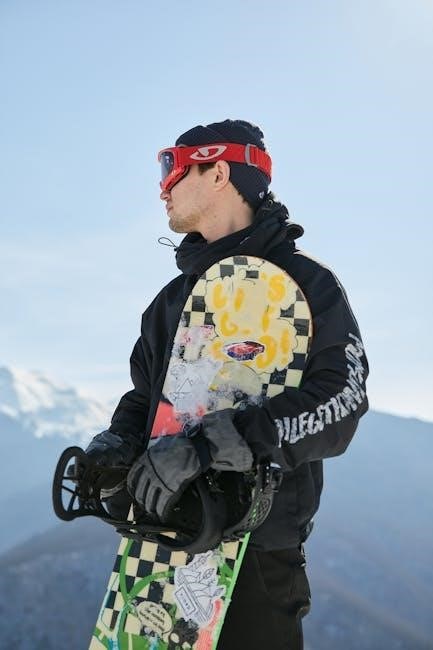Discover how lens color impacts your skiing experience. This guide explains the science behind tint options, helping you choose the perfect shade for optimal visibility and performance on the slopes.
Understanding the Importance of Lens Colour in Ski Goggles
Lens colour plays a crucial role in enhancing your skiing experience by optimizing visibility and comfort. Different tints are designed to perform best under specific light conditions, ensuring clarity and reducing eye strain. For instance, yellow and pink lenses excel in low-light scenarios by boosting contrast, while grey and black lenses minimize glare in bright environments. The right colour helps you see terrain details more clearly, reducing hazards and improving reaction time. Additionally, lens colour affects visible light transmission (VLT), which determines how much light enters the goggles. By selecting the appropriate tint, you can adapt to varying weather and lighting conditions, ensuring better performance and safety on the slopes. This guide will help you make an informed choice tailored to your skiing needs.
How Lens Colour Affects Visibility and Performance
Lens colour significantly impacts visibility and performance by filtering light and enhancing contrast. In low-light conditions, warm tints like yellow or pink amplify available light, improving clarity and depth perception. Conversely, cool tints such as blue or purple enhance contrast in snowy environments, making it easier to spot terrain variations. Neutral tints like grey reduce glare without distorting colours, ideal for bright days. The right tint reduces eye strain and improves reaction time, crucial for navigating challenging slopes. By tailoring lens colour to specific conditions, skiers can optimize visual acuity, ensuring safer and more enjoyable experiences. Proper lens selection is essential for maximizing performance and comfort, regardless of weather or lighting conditions.


Key Factors to Consider When Choosing Lens Colour
When selecting lens colour, consider light conditions, VLT, and personal preference. These factors ensure optimal visibility, comfort, and performance for your skiing adventures.
Visible Light Transmission (VLT) and Its Impact on Lens Performance
Visible Light Transmission (VLT) measures how much light passes through a lens, ranging from 0% to 100%. Higher VLT allows more light, ideal for low-light conditions, while lower VLT reduces glare in bright environments. For instance, clear lenses with high VLT (around 90-100%) are perfect for night skiing, enhancing visibility in dim settings. Conversely, dark-tinted lenses with low VLT (10-20%) are better for sunny days, minimizing glare and protecting eyes from intense light. Understanding VLT helps skiers choose lenses that optimize their vision in various conditions, ensuring clarity and comfort on the slopes. This balance is crucial for safety and performance, making VLT a key consideration in selecting ski goggles.
Light Conditions: Sunny, Cloudy, Flat Light, and Low Light
Different light conditions demand specific lens tints for optimal vision. Sunny days require lenses with low VLT to reduce glare, while cloudy or overcast skies benefit from medium VLT for balanced visibility. Flat light, common in snowy or foggy environments, calls for tints like yellow or pink to enhance contrast. Low-light conditions, such as early mornings or evenings, necessitate high VLT lenses to maximize light intake. Understanding these variations ensures skiers can adapt their gear to maintain clarity and safety. Proper lens selection based on light conditions enhances performance and reduces eye strain, making it a critical factor in choosing the right ski goggles for any situation.

Colour Guide for Specific Skiing Conditions
From sunny slopes to low-light runs, this guide matches lens colors to skiing conditions, ensuring optimal visibility and comfort in any mountain environment with precise tint recommendations.
Yellow and Pink Lenses: Best for Low Light Conditions
Yellow and pink lenses are specifically designed for low-light conditions, enhancing contrast and depth perception. These tints amplify available light, making them ideal for cloudy or early morning skiing. They reduce eye strain and improve visual clarity in flat light, providing better definition of terrain features. Yellow lenses are particularly effective at cutting through haze, while pink ones offer a more natural color perception. Both options are excellent for skiing in overcast weather or during dawn and dusk when light is limited. Their ability to boost contrast ensures that skiers can navigate challenging conditions with greater confidence and safety.

Copper, Rose, and Brown Lenses: Universal Options for Medium Light
Copper, rose, and brown lenses are versatile choices for medium-light conditions, offering excellent visibility and contrast. These tints enhance depth perception while maintaining natural color accuracy, making them suitable for a wide range of skiing environments. Copper lenses excel at reducing glare and improving clarity in sunny to partly cloudy conditions, while rose and brown tints provide soothing comfort for the eyes. They are ideal for skiers who experience varying light throughout the day, as they balance light transmission and glare reduction effectively. These lenses are a popular choice for their ability to perform well in both bright and moderate light, ensuring consistent visual performance on the slopes.
Grey and Black Lenses: Reducing Glare in Bright Conditions
Grey and black lenses are specifically designed to reduce glare in bright, sunny conditions, making them ideal for skiers who frequent well-lit slopes. Grey lenses offer a neutral tint that minimizes color distortion while effectively reducing glare, providing clear vision in high-light environments. Black lenses, on the other hand, are darker and often used in extreme brightness, such as at high altitudes or on snow-covered terrain. Both options are excellent for reducing eye strain caused by intense sunlight. However, they may not perform as well in flat or low-light conditions due to their lower VLT. These lenses are a great choice for skiers prioritizing glare reduction in sunny settings.
Blue and Purple Lenses: Enhancing Contrast in Snowy Environments
Blue and purple lenses are designed to enhance contrast in snowy environments, making them ideal for skiers who often face flat light or overcast conditions. These tints work by filtering out certain wavelengths of light, such as yellow and orange, which are commonly present in snowy settings. This filtration creates sharper definition between snow textures and depths, improving visibility and reducing eye strain. Blue lenses are particularly effective at reducing glare from snow, while purple lenses offer a balance between contrast enhancement and color accuracy. Both options are popular among skiers who need to navigate challenging, low-contrast environments. However, they may not perform as well in bright, sunny conditions due to their lower VLT, making them best suited for cloudy or snowy days.

Specialized Lens Options
Specialized lenses, like mirrored and interchangeable options, offer enhanced performance. Mirrored lenses reduce glare, while interchangeable ones adapt to changing light conditions, ensuring optimal vision in any setting.
Mirrored Lenses: Reducing Glare and Improving Style
Mirrored lenses are a popular choice for ski goggles, offering both functionality and style. The reflective coating on these lenses helps reduce glare from snow and sunlight, enhancing visibility and reducing eye strain. This feature is particularly beneficial in bright conditions, such as skiing on sunny days or reflective snow surfaces. Additionally, mirrored lenses can improve the overall aesthetic appeal of the goggles, making them a fashionable accessory on the slopes. However, it’s important to note that while they reduce glare, they may not necessarily improve low-light visibility, making them more suited for specific lighting environments rather than all conditions.
Interchangeable Lenses: Versatility for Changing Conditions
Interchangeable lenses offer unparalleled versatility for skiers and snowboarders, allowing quick adaptation to changing light conditions. With interchangeable lenses, you can easily switch between different tints to suit the environment, ensuring optimal clarity and visibility. This feature is especially useful for athletes who ski in varying weather, from sunny days to flat light conditions. Many modern goggles, such as the Smith Mag series, feature easy-to-change lens systems, enabling seamless transitions without compromising goggle performance; This convenience eliminates the need to carry multiple pairs of goggles, making it a practical choice for enthusiasts who prioritize adaptability and convenience on the mountain.

Additional Features to Consider

Beyond lens color, consider vents and turbo fans to prevent fogging, as well as lens shape options like cylindrical or spherical for improved field of view and optical clarity.
Vents and Turbo Fans: Preventing Fogging
Vents and turbo fans are crucial features in ski goggles, designed to prevent fogging and maintain clear vision. Proper ventilation systems ensure moisture is efficiently wicked away, reducing fog buildup caused by temperature differences or intense physical activity. Many goggles feature top, side, and frame vents that promote airflow without compromising protection; Turbo fans take this a step further by actively circulating air within the goggles, significantly enhancing moisture removal. These features are especially beneficial in humid or changing weather conditions, ensuring optimal clarity and comfort throughout your skiing experience. By integrating advanced ventilation technology, goggles provide reliable performance, keeping your vision sharp and unobstructed. This ensures you stay focused on the slopes, no matter the conditions.
Lens Shape: Cylindrical vs. Spherical Lenses
When selecting ski goggles, the lens shape plays a significant role in optical clarity and performance. Cylindrical lenses are curved horizontally and are generally more affordable, offering decent optical clarity in medium to bright light conditions. They are a great option for skiers who prioritize cost-effectiveness without compromising on essential functionality. On the other hand, spherical lenses are curved both horizontally and vertically, providing superior optical accuracy and reducing distortion. This makes them ideal for low-light conditions and enhances peripheral vision, which is crucial for spotting obstacles. Spherical lenses also reduce eye strain and are more durable, though they come at a higher price point. Choosing the right lens shape depends on your skiing conditions, budget, and personal preferences.
Choosing the right ski goggle lens color enhances visibility, reduces glare, and improves performance. Prioritize your skiing conditions and preferences to make an informed, optimal decision.
Final Tips for Selecting the Perfect Ski Goggles Lens Colour

When choosing ski goggle lens color, assess the primary light conditions you’ll ski in. For versatility, opt for interchangeable lenses to adapt to changing weather. Consider VLT percentages—lower for bright days, higher for low light. Test lenses on snow if possible to gauge comfort and clarity. Mirrored coatings can enhance glare reduction while maintaining style. Don’t overlook cylindrical vs. spherical lenses; spherical offers wider vision. Prioritize your needs: contrast, glare reduction, or neutral color accuracy. Combine these factors with personal preference to find the ideal lens color for your skiing adventures, ensuring sharp vision and enhanced performance on the slopes.
